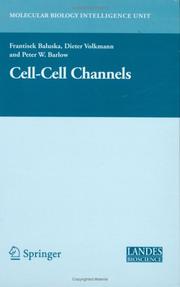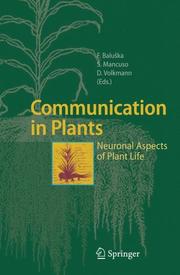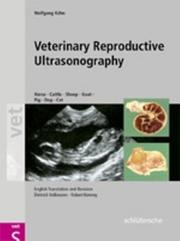| Listing 1 - 6 of 6 |
Sort by
|

ISBN: 1280969873 9786610969876 0387469575 0387360581 1493901214 Year: 2006 Publisher: Georgetown, Tex. : New York : Landes Bioscience / Eurekah.com ; Springer Science+business Media,
Abstract | Keywords | Export | Availability | Bookmark
 Loading...
Loading...Choose an application
- Reference Manager
- EndNote
- RefWorks (Direct export to RefWorks)
he biological sciences are dominated by the idea that cells are the functionally autonomous, physically separated, discrete units of life. TThis concept was propounded in the 19th century by discoveries of the cellular structuring of both plants and animals. Moreover, the ap parent autonomy of unicellular eukaryotes, as well as the cellular basis of the mammalian brain (an organ whose anatomy for a long while defied attempts to validate the idea of the cellular nature of its neurons), seemed to provide the final conclusive evidence for the completeness of *cell theory', a theory which has persisted in an almost dogmatic form up to the present day. However, it is very obvious that there are numerous observations which indicate that it is not the cells which serve as the basic units of biological life but that this property falls to some other, subcellular assemblage. To deal with this intricate problem concerning the fundamental unit of living matter, we proposed the so-called Cell Body concept which, in fact, devel ops an exceedingly original idea proposed by Julius Sachs at the end of the 19th century. In the case of eukaryotic cells, DNA-enriched nuclei are intimately associated with a microtubular cytoskeleton. In this configuration—as a Cell Body—these two items comprise the fundamental functional and struc tural unit of eukaryotic living matter. The Cell Body seems to be inherent to all cells in all organisms.
Cell junctions. --- Cell interaction. --- Cells --- Cell membranes. --- Permeability. --- Cell surfaces --- Cytoplasmic membranes --- Plasma membranes --- Plasmalemma --- Membranes (Biology) --- Glycocalyces --- Cell membranes --- Cell-cell interaction --- Cell communication --- Cellular communication (Biology) --- Cellular interaction --- Intercellular communication --- Cellular control mechanisms --- Junctions, Cell --- Cell interaction --- Membrane fusion --- Cytology. --- Developmental biology. --- Biochemistry. --- Cell Biology. --- Developmental Biology. --- Plant Biochemistry. --- Biological chemistry --- Chemical composition of organisms --- Organisms --- Physiological chemistry --- Biology --- Chemistry --- Medical sciences --- Development (Biology) --- Growth --- Ontogeny --- Cell biology --- Cellular biology --- Cytologists --- Composition --- Cell biology. --- Plant biochemistry. --- Phytochemistry --- Plant biochemistry --- Plant chemistry --- Biochemistry --- Botany --- Phytochemicals --- Plant biochemical genetics
Digital
ISBN: 9780387469577 Year: 2006 Publisher: New York, NY Landes Bioscience and Springer Science+Business Media, LLC
Abstract | Keywords | Export | Availability | Bookmark
 Loading...
Loading...Choose an application
- Reference Manager
- EndNote
- RefWorks (Direct export to RefWorks)
General embryology. Developmental biology --- Histology. Cytology --- Biochemical engineering --- embryologie (biologie) --- biochemie --- cytologie --- histologie --- planten

ISBN: 9783540285168 9783540284758 Year: 2006 Publisher: Berlin Springer-Verlag
Abstract | Keywords | Export | Availability | Bookmark
 Loading...
Loading...Choose an application
- Reference Manager
- EndNote
- RefWorks (Direct export to RefWorks)
Histology. Cytology --- Plant physiology. Plant biophysics --- Physiology of nerves and sense organs --- Biochemical engineering --- systematische plantkunde --- biochemie --- cytologie --- histologie --- planten --- neurobiologie

ISBN: 3899930053 Year: 2004 Publisher: Hannover : Schlütesche,
Abstract | Keywords | Export | Availability | Bookmark
 Loading...
Loading...Choose an application
- Reference Manager
- EndNote
- RefWorks (Direct export to RefWorks)
Diagnostic imaging --- Ultrasonography --- Genitalia, female --- Horses --- Cattle --- Sheep --- Goats --- Swine --- Dogs --- Cats --- veterinary --- veterinary --- ultrasonography --- Diagnostic imaging --- Ultrasonography --- Genitalia, female --- Horses --- Cattle --- Sheep --- Goats --- Swine --- Dogs --- Cats --- veterinary --- veterinary --- ultrasonography

ISBN: 9783540285168 9783540284758 3540284753 3642066720 9786610608720 1280608722 3540285164 Year: 2006 Publisher: Berlin, Heidelberg Springer Berlin Heidelberg
Abstract | Keywords | Export | Availability | Bookmark
 Loading...
Loading...Choose an application
- Reference Manager
- EndNote
- RefWorks (Direct export to RefWorks)
Plant neurobiology is a newly emerging field of plant sciences. It covers signalling and communication at all levels of biological organization – from molecules up to ecological communities. In this book, plants are presented as intelligent and social organisms with complex forms of communication and information processing. Authors from diverse backgrounds such as molecular and cellular biology, electrophysiology, as well as ecology treat the most important aspects of plant communication, including the plant immune system, abilities of plants to recognize self, signal transduction, receptors, plant neurotransmitters and plant neurophysiology. Further, plants are able to recognize the identity of herbivores and organize the defence responses accordingly. The similarities in animal and plant neuronal/immune systems are discussed too. All these hidden aspects of plant life and behaviour will stimulate further intense investigations in order to understand the communicative plants in their whole complexity.
Histologie. Cytologie --- Fysiologie en biofysica der planten --- Neurofysiologie. Zintuigfysiologie --- Industriële biochemie --- systematische plantkunde --- biochemie --- cytologie --- histologie --- planten --- neurobiologie --- Plant cellular signal transduction --- Plant physiology --- Plant physiology. --- Cytology. --- Biochemistry. --- Botany. --- Neurobiology. --- Plant Physiology. --- Cell Biology. --- Plant Biochemistry. --- Plant Sciences. --- Neurosciences --- Botany --- Plants --- Physiology --- Botanical science --- Phytobiology --- Phytography --- Phytology --- Plant biology --- Plant science --- Biology --- Natural history --- Biological chemistry --- Chemical composition of organisms --- Organisms --- Physiological chemistry --- Chemistry --- Medical sciences --- Cell biology --- Cellular biology --- Cells --- Cytologists --- Composition --- Cell biology. --- Plant biochemistry. --- Plant science. --- Phytochemistry --- Plant biochemistry --- Plant chemistry --- Biochemistry --- Phytochemicals --- Plant biochemical genetics --- Floristic botany --- Acqui 2006 --- Plant cellular signal transduction.

ISBN: 9780387360584 9780387469577 Year: 2006 Publisher: New York, NY Landes Bioscience and Springer Science+Business Media, LLC
Abstract | Keywords | Export | Availability | Bookmark
 Loading...
Loading...Choose an application
- Reference Manager
- EndNote
- RefWorks (Direct export to RefWorks)
he biological sciences are dominated by the idea that cells are the functionally autonomous, physically separated, discrete units of life. TThis concept was propounded in the 19th century by discoveries of the cellular structuring of both plants and animals. Moreover, the ap parent autonomy of unicellular eukaryotes, as well as the cellular basis of the mammalian brain (an organ whose anatomy for a long while defied attempts to validate the idea of the cellular nature of its neurons), seemed to provide the final conclusive evidence for the completeness of *cell theory', a theory which has persisted in an almost dogmatic form up to the present day. However, it is very obvious that there are numerous observations which indicate that it is not the cells which serve as the basic units of biological life but that this property falls to some other, subcellular assemblage. To deal with this intricate problem concerning the fundamental unit of living matter, we proposed the so-called Cell Body concept which, in fact, devel ops an exceedingly original idea proposed by Julius Sachs at the end of the 19th century. In the case of eukaryotic cells, DNA-enriched nuclei are intimately associated with a microtubular cytoskeleton. In this configuration as a Cell Body these two items comprise the fundamental functional and struc tural unit of eukaryotic living matter. The Cell Body seems to be inherent to all cells in all organisms.
| Listing 1 - 6 of 6 |
Sort by
|

 Search
Search Feedback
Feedback About UniCat
About UniCat  Help
Help News
News